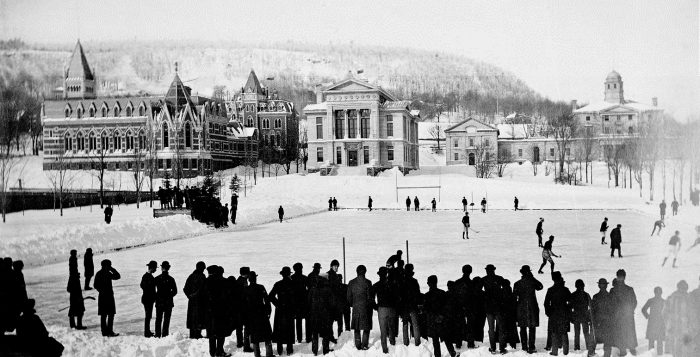This Day in Hockey History – January 27, 1883 – First Ornament Tournament
(Photo: McGill University, 1884 Winter Carnival, via Wikimedia Commons)
In Montreal, it did not take hockey long to catch on. Six years after the rules first were published there in 1877, hockey’s popularity dramatically increased after the 1883 Winter Carnival. Local businessmen and politicians organized the annual celebration to boost the seasonally sagging local economy,” and usually at least 50,000 visitors attended. “As part of the festivities, three teams played a round-robin tournament that is considered the world’s first championship ice hockey tournament.
The Montreal Gazette helped advertise the upcoming tournament calling for “all bona fide hockey clubs, will be played under the standard rules of hockey.” Two Montreal teams, the Victorias and McGill University, and a Quebec team signed up. Since Quebec only brought seven players, the other teams agreed to sit two of their nine.
The tournament featured two games on Friday, January 26 and two more on Saturday, January 27. The scraped surface on the frozen St. Lawrence River was in terrible condition on Friday and couldn’t be used on Saturday. Instead, the morning game was held at Crystal Rink and the afternoon game at Victoria Rink. Each game included two half-hour sessions with a 10-minute intermission. The games were well attended, especially by fans of McGill.
As it turned out, the teams must have been fairly evenly matched because three of the four games ended in a draw. After the first matchup between the Victoria and Quebec clubs, the Montreal Gazette noted, “Although the Victorias played with the sun it was evident from the start that their chance of victory was slight.” However, after their second matchup, the analysis was that “Victoria, as usual, was strong in its back play, while the forward play of Quebec was simply superb.” According to the Gazette, for the next set of opponents, “Victoria made much the neatest play, but McGill had the advantage in weight.” In comparing the Quebec team to McGill’s team, the Gazette decided, “The teams were very closely matched; what Quebec lacked in weight and strength they made up in skill.”
The first game took place at 11 am on Friday between Quebec and the Victorias. Although the “Quebecers played a splendid game all round,” the only goal of the game was disallowed because the “rubber” had “been out of play.” The game ended 0-0.
The Victorias lost the toss, so they had the double-header. Two of their players had been injured, so they swapped them out for their two remaining. The Victorias played McGill at 3 that afternoon. The first half of the game remained scoreless, but McGill scored about fifteen minutes into the second. Victoria’s goal was fouled, so McGill won 1-0.
The next day, McGill and Quebec played at 11:30. McGill scored about nine minutes into the game, but then Quebec scored twice. At the very end of the game, McGill tied at 2-2. The Montreal Gazette summarized, “The game was rather rough all through, and the play was by no means what might have been expected, but this may have been on account of the small space [at Crystal Rink].”
Finally, Quebec and the Victorias played each other again that afternoon. The Gazette crowed that this was “an exhibition of how the game should be played.” Victoria scored first because Quebec was stiff from their morning bout. However, this “seemed to work [Quebec] up,” and they scored ten minutes later. After half time, they switched sides, but neither managed another goal. The tournament ended with their 1-1 draw.
In the end, McGill was the only team to actually win a game, and it was only by one goal. As the winners, they received a “solid silver Carnival cup and clasps.” The Winter Carnival Cup can be viewed at the McCord Museum in Montreal. Then it was valued at $750, which now is worth about $20,000. “The idea that players could and would compete for a trophy – and a valuable one,” wrote Michael McKinley in Hockey: A People’s History, “reveals just how quickly hockey had taken hold of the Canadian imagination.”
Montreal’s Winter Carnival continued to impact the sport. After the tournament in 1886, the Amateur Hockey Association of Canada was established. The 1889 tournament was the first time Lord Stanley watched hockey, and since 1893, his cup has been awarded to the winners of the highest level of tournament played in North America.
Additional Sources:
- “The Winter Carnival,” Montreal Gazette, 20 Jan. 1883, p. 7.
- “The Carnival: The Hockey Matches,” Montreal Gazette, 27 Jan. 1883, p. 8.
- “The Carnival: The Hockey Matches,” Montreal Gazette, 29 Jan. 1883, p. 2.
- “The Winter Carnival,” Montreal Daily Witness, 27 Jan. 1883, p. 8.
- “The Winter Carnival,” Montreal Daily Witness, 29 Jan. 1883, p. 4.
- Michael McKinley, Hockey: A People’s History (McClelland & Stewart, 2009), kindle version.
- Malcolm G. Kelly and Mark Askin, The Complete Idiot’s Guide to Hockey (Penguin, 2001), 8.
- John Chi-Kit Wong, Lords of the Rinks: The Emergence of the National Hockey League, 1875-1936 (University of Toronto Press, 2005), kindle version.
- Jenny Ellison and Jennifer Anderson, Hockey: Challenging Canada’s Game – Au-delà du sport national (University of Ottawa Press, 2018), 27-28.















[…] https://thepinkpuck.com/2019/01/27/this-day-in-hockey-history-january-27-1883-first-ornament-tournam… […]